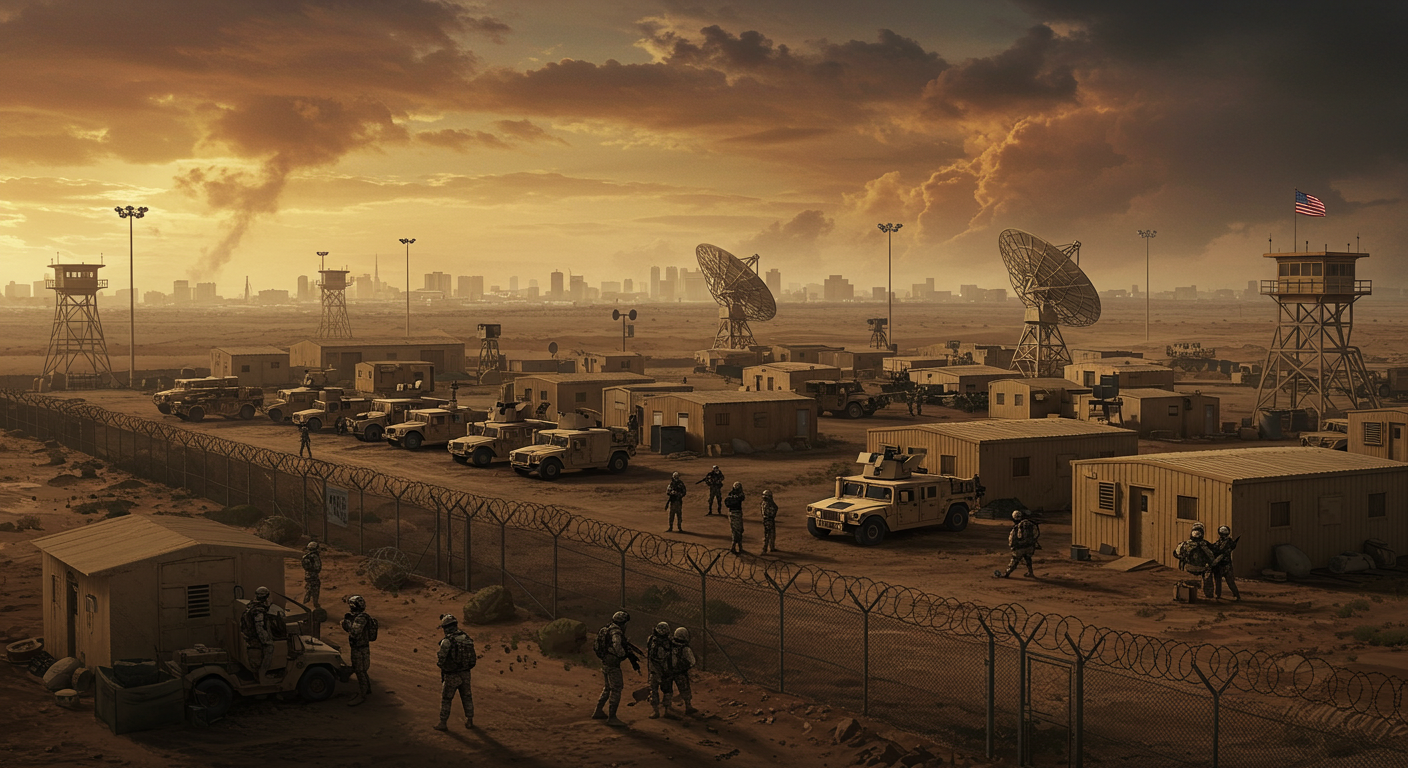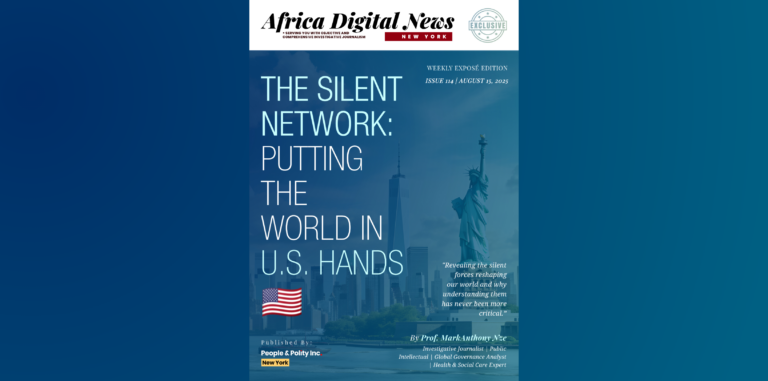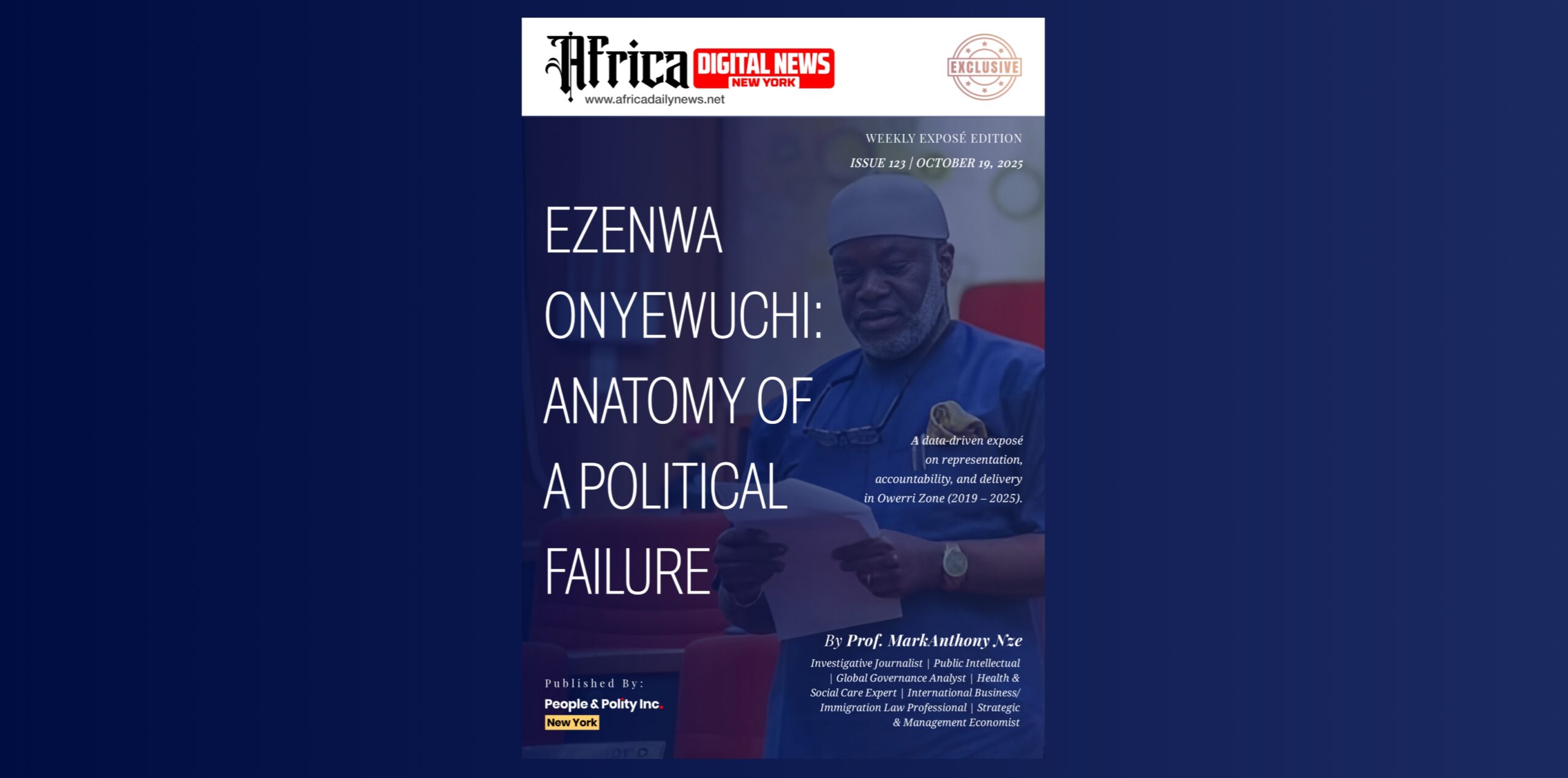“Revealing the silent forces reshaping our world and why understanding them has never been more critical.”
By Prof. MarkAnthony Nze
Investigative Journalist | Public Intellectual | Global Governance Analyst | Health & Social Care Expert
Executive Summary
The Silent Network Putting the World in U.S. Hands is a forensic, high-clarity investigation into the hidden architecture of American global power—an interconnected system of military, economic, intelligence, technological, and cultural levers designed to operate with precision and deniability. Far from being an ad hoc accumulation of influence, this network is the product of decades of calculated strategy, refined from the post–World War II order to the digital age.
The study traces its origins to the Bretton Woods settlement, where economic institutions like the IMF and World Bank became early instruments of leverage. It details the Pentagon’s lattice of over 80 overseas military bases, maintained through opaque agreements that guarantee U.S. presence far beyond its borders. Economic warfare—anchored in the petrodollar, sanctions, and control of the SWIFT banking system—emerges as a silent coercive force capable of reshaping nations without military confrontation.
The surveillance state is revealed as the empire’s central nervous system, spanning programs like PRISM and XKeyscore, embedded into allied infrastructures and exported to strategic partners under the guise of security cooperation. Big Tech serves as both amplifier and enforcer—shaping narratives, moderating discourse in alignment with state policy, and integrating AI and data systems into military-intelligence frameworks.
Cultural power, from Hollywood productions to wire service news framing, quietly molds global perception, normalizing U.S. priorities and interventions. Corporate giants, aid agencies, and NGOs extend economic influence under the banner of development, locking states into structural dependencies.
Yet the report also charts the rise of resistance—BRICS alliances, sovereign tech initiatives, and counter-narratives challenging U.S. supremacy. These forces signal a future where the “silent network” may face fragmentation, forcing the question: will America’s grip tighten or loosen in an increasingly multipolar world?
This is not simply an exposé—it is a decoded manual of modern hegemony, revealing how the battle for the 21st century will be fought over control of capital flows, data pipelines, and the global story itself.
An unmasking of the invisible architecture of military, financial, technological, and cultural dominion through which the United States orchestrates global power without ever raising its flag.
Part 1 — Blueprint of a Modern Empire

How post-war America built a global order where its dominance is quietly embedded into every financial, military, and political institution.
The end of the Second World War marked not only the defeat of fascism but the emergence of a new kind of world order — one architected with meticulous precision by the United States. Far from being a spontaneous outcome of wartime victory, the post-1945 system was the product of deliberate design: a strategic blueprint that combined economic dominance, institutional power, and a global security framework to ensure long-term primacy.
Post-War Context: From Arsenal to Architect
In 1945, the United States accounted for over half of the world’s industrial output and controlled the majority of global gold reserves (National WWII Museum, 2020). This unparalleled position gave Washington not just the capacity but the leverage to dictate the terms of the post-war settlement. The transition from an isolationist republic to the self-declared “leader of the free world” was neither accidental nor universally popular. Policymakers recognized that the devastation of Europe and Asia created a unique opportunity to embed American power within the very infrastructure of global governance (Lekkas, n.d.).
Harry Truman, inheriting the presidency after Roosevelt’s death, became the chief steward of this vision. His administration oversaw the creation of a network of international institutions — from the United Nations to NATO — designed not only to prevent another global conflict but to lock in the economic and security advantages won on the battlefield (Frank, 2022).
Bretton Woods: Writing the Rules of the Game
Even before the war ended, the 1944 Bretton Woods Conference demonstrated how the United States intended to institutionalize its advantage. Delegates from 44 Allied nations gathered to stabilize the post-war economy, but it was American Treasury officials, armed with superior financial leverage, who dictated the key terms (Council on Foreign Relations, 2023). The creation of the International Monetary Fund (IMF) and the World Bank under U.S. leadership — with voting rights proportional to financial contributions — ensured Washington’s enduring influence over global economic policy.
The dollar’s peg to gold, backed by the United States’ massive reserves, made it the world’s reserve currency by default (National WWII Museum, 2022). This wasn’t just monetary housekeeping — it was the foundation of an economic order in which trade, finance, and liquidity revolved around American stability.
The Marshall Plan: Aid as Architecture
If Bretton Woods was about global rules, the Marshall Plan was about securing the West’s allegiance. Announced in 1947, it committed $13 billion to Europe’s reconstruction, revitalizing economies devastated by war (National WWII Museum, 2022). Ostensibly humanitarian, the plan strategically tied Western Europe’s recovery to U.S. markets, technology, and currency.
The initiative did more than rebuild; it reconfigured economic dependencies. Infrastructure rebuilt with U.S. funding often relied on American suppliers, and aid agreements sometimes came with political expectations — from resisting communist influence to supporting U.S.-backed trade liberalization (National WWII Museum, 2022). As scholars have noted, this was “emergency aid” with an indefinite shelf life, creating a web of interdependence that aligned European prosperity with American leadership (Lekkas, n.d.).
Security Architecture: The Truman Doctrine and NATO
Economic leverage was only half the equation. The Truman Doctrine of 1947 signaled an unprecedented U.S. commitment to intervene against perceived threats to the “free world” (Frank, 2022). NATO’s founding in 1949 institutionalized a permanent American military presence in Europe, with parallel alliances in Asia reinforcing the same logic.
The Financial Times has traced this post-war national security posture back to the New Deal era, when the federal government embraced the notion that economic stability and security were inseparable (Financial Times, n.d.). These alliances did more than deter the Soviet Union — they established a precedent that the United States would maintain forward-deployed forces in peacetime, shaping strategic realities for decades.
Institutionalizing Influence: The Role of Information and Archives
Much of what we now understand about the blueprint of U.S. post-war power comes from declassified government files, made accessible through the Freedom of Information Act and curated by institutions like the National Security Archive (ProQuest, 2025a). These documents reveal the behind-the-scenes debates between officials advocating for aggressive global engagement and those urging caution.
For example, internal memoranda show that while public rhetoric emphasized mutual benefit, strategic planners were clear-eyed about the asymmetrical advantages the United States would gain from institutional leadership (ProQuest, 2025b). The gap between soldiers’ hopes for a return to normalcy and policymakers’ determination to entrench global commitments underscores the contested nature of the post-war order (Lekkas, n.d.).
The Quiet Consolidation of Power
By the early 1950s, the core pillars of U.S. dominance were firmly in place:
- Economic leadership via Bretton Woods institutions and the dollar’s reserve status.
- Security guarantees through NATO and bilateral alliances.
- Cultural influence embedded in media, technology, and trade.
This system, often described as the “liberal international order,” presented itself as a cooperative framework, but as The Guardian has argued, it often prioritized market openness and geopolitical stability over more equitable or democratic forms of governance (Malik, 2025).
While its architects celebrated its role in preventing another world war, critics noted that it preserved U.S. hegemony as much as it promoted peace. The Financial Times has observed that the durability of this system lies in its “plumbing” — the habitual reliance on U.S.-centered mechanisms for crisis resolution, trade, and security (Financial Times, 2024).
Conclusion: The Empire Without the Name
What emerged after 1945 was not an empire in the traditional sense of territorial conquest, but an empire of systems. The post-war blueprint fused economic rules, military alliances, and political institutions into a self-reinforcing order that normalized U.S. leadership as the default condition of global politics.
As Truman himself remarked, the goal was not simply to win the war but to “win the peace” — a peace defined on American terms (Frank, 2022). This quiet empire endures precisely because it does not declare itself as such; it is embedded in the structures through which the modern world operates.
Part 2 — Military Web Without Borders

How a sprawling lattice of outposts, hubs, and legal instruments gives Washington reach without borders.
2.0 The unseen architecture of power
When examined from a strategic perspective, maps reveal the world not merely as a collection of continents and countries, but as an interconnected network of runways, ports, pre-positioned stockpiles, and status-of-forces clauses. That mesh is the United States’ overseas posture. It is less a collection of isolated forts than an operating system for power projection that Washington can scale up, dial down, or reroute in days. It is also expensive and politically contested—at home and abroad—which is why the debate over how much, where, and why now sits at the heart of U.S. grand strategy (Congressional Research Service, 2024; RAND Corporation, 2024; Defense Priorities, 2025).
2.1 By the numbers: scale, types, cost
The contemporary posture spans main operating bases (long-term, heavily resourced), forward operating sites (smaller, often rotational), and cooperative security locations (host-nation sites usable when needed) (Congressional Research Service, 2024). Independent budget watchdogs estimate the U.S. operates 750+ overseas sites at an annual cost of roughly $66 billion—a figure that captures why fiscal pressure regularly drives calls for consolidation (Taxpayer for Common Sense, 2025). From a military standpoint, the mix hedges risk: large bases deliver scale, smaller sites deliver flexibility, and access agreements reduce political friction (International Institute for Strategic Studies, 2022).
2.2 Why they are where they are
Placement is not accidental. Bases cluster along maritime chokepoints, air corridors, and near likely flashpoints. In the Middle East, for example, U.S. forces maintain concentration in and around the Gulf—Bahrain, Kuwait, Qatar, the UAE, and rotational presences in Iraq and Syria—to assure oil-lane security, deter Iran, and sustain counter-ISIS pressure (Council on Foreign Relations, 2025a). In Europe, posture hugs NATO’s northeastern flank and logistics hubs in Germany, Poland, Italy, the Baltics, and the UK, balancing deterrence with reinforcement speed (Council on Foreign Relations, 2025b). The pattern reflects a simple proposition: geography is strategy when you need hours, not weeks, to move combat power (International Institute for Strategic Studies, 2022; Congressional Research Service, 2024).
2.3 The legal plumbing: SOFAs, access, and immunity
What turns an airfield abroad into a reliable node of American power is not just concrete—it is law. Status of Forces Agreements (SOFAs) and host-nation accords define criminal jurisdiction, entry/exit rules, tax treatment, labor law coverage, and environmental obligations. Their cumulative effect is to create predictability and partial extraterritoriality for U.S. forces, enabling 24/7 operations with limited legal friction (Congressional Research Service, 2024; International Institute for Strategic Studies, 2022). These texts are often dry; their consequences are not. A carefully negotiated waiver here, a customs rule there, and suddenly aircraft turn in hours instead of days.
2.4 Europe in practice: deterrence by presence and pathway
Europe demonstrates the posture’s dual logic: persistent presence plus reinforcement pathways. Germany remains a logistics brain and medical/airlift hub; Poland and the Baltic States anchor the eastern forward edge; the UK and Italy host key air and maritime enablers (Council on Foreign Relations, 2025b). Since 2014—and more sharply after 2022—NATO’s force posture has added enhanced forward presence and prepositioned stocks, compressing response times and signaling that any incursion would trigger immediate multinational movement (Congressional Research Service, 2024; International Institute for Strategic Studies, 2022). The strategy is not to match adversary forces soldier-for-soldier on the frontier, but to prove the road is short from rear areas to the line of contact.
2.5 The Gulf and Levant: depth, denial, and daily tempo
In the Gulf, Bahrain hosts Fifth Fleet for maritime security; Qatar’s Al Udeid provides a regional air nerve center; Kuwait hosts ground logistics; the UAE offers air and maritime access; Iraq/Syria rotations maintain counter-ISIS pressure and ISR coverage (Council on Foreign Relations, 2025a). The sum is depth (multiple bases), denial (control of air/sea), and tempo (ISR, strike, and refueling cycles that never stop). Because these sites sit near shipping arteries and contested airspace, they also give Washington crisis leverage short of war—sanctions backed by visible force posture carry more weight when tankers know who controls the straits (International Institute for Strategic Studies, 2022).
2.6 Indo-Pacific realities: distance, dispersion, resilience
The Indo-Pacific forces a different geometry: vast distances and peer-level threats. Here, posture planning emphasizes dispersion, hardening, camouflage, deception, and rapid runway repair—all to keep aircraft flying under missile threat (RAND Corporation, 2025a). Japan (especially Okinawa), Guam, the Northern Marianas, Australia, and growing access around Southeast Asia form a ladder of bases and lily pads to complicate adversary targeting and preserve operational tempo (International Institute for Strategic Studies, 2022). RAND’s recent assessment argues that investments in air base resilience—from fuel distribution to expeditionary arresting gear—are as decisive as buying more aircraft, because survivability of the airfield is the true sortie generator (RAND Corporation, 2025a).
2.7 The quiet layer: logistics and prepositioning
Bases are the visible pins; logistics is the invisible thread. The posture depends on prepositioned materiel (munitions, spares, fuel), sealift, aerial refueling, medical evacuation, and global C2 networks. CRS details how Army APS, Maritime Prepositioning Force squadrons, and Air Force global mobility shrink timelines from weeks to days (Congressional Research Service, 2024). The IISS likewise stresses the importance of distributed fuel storage, redundant comms, and host-nation infrastructure upgrades: base access without fuel or bandwidth is a mirage (International Institute for Strategic Studies, 2022).
2.8 Who pays, who benefits: burden-sharing and the $66 billion question
Host nations often co-finance: Japan and South Korea subsidize utilities, construction, and local labor; European allies fund infrastructure to NATO standards (Congressional Research Service, 2024). In Washington, critics argue the network overextends resources and locks the U.S. into every crisis; advocates reply that deterrence miles forward is cheaper than fighting at home (RAND Corporation, 2024). Budget watchdogs put hard numbers to the debate: $66 billion per year is the estimated overseas basing bill; closing or consolidating selected sites could save billions without eroding core security, they contend (Taxpayer for Common Sense, 2025). The strategic question is not simply cost, but return on posture: which locations measurably reduce risk or buy response time, and which persist mostly out of habit?
2.9 A comparator: China’s still-nascent footprint
Beijing’s presence abroad is growing—Djibouti is open, Cambodia’s Ream and other rumors swirl—but even China-focused analysts caution that scale and function matter. A recent review of open-source and RAND analysis judged that China’s overseas basing is “not a big threat—yet”, both in numbers and in the enabling logistics required to sustain far-flung, high-tempo operations (Defense One, 2024). IISS reaches a similar conclusion: a globally projectable posture demands not just a pier and a flag, but airlift, sealift, munitions stockpiles, secure C2, and political access under stress—capabilities the U.S. has refined over decades (International Institute for Strategic Studies, 2022).
2.10 Sovereignty, politics, and friction at the edge
No base exists in a vacuum; each sits inside a domestic political debate. Noise, accidents, land use, environmental risk, and jurisdictional disputes generate local backlash; national governments juggle sovereignty optics with security needs (Congressional Research Service, 2024). In Europe, posture adjustments after 2014 won broad elite backing, but host-nation courts and parliaments still scrutinize environmental and legal terms (Council on Foreign Relations, 2025b). In the Gulf, leaders balance U.S. access with regional diplomacy; in Asia, alliance politics must now account for missile threat to civilian populations, making air base resilience as much a political as a technical question (RAND Corporation, 2025a).
2.11 The posture we need next: fewer monuments, more options
The most compelling reform arguments do not call for abandonment but for adaptation: fewer large, conspicuous “monuments”, more distributed, host-integrated options; tighter prioritization against core U.S. interests; and clearer metrics for deterrence and crisis response (Defense Priorities, 2025). RAND’s defense-strategy work likewise emphasizes aligning ends, ways, and means: posture should improve campaign outcomes, not just symbolize commitment (RAND Corporation, 2024). In the Indo-Pacific especially, that means hardening what you must keep, dispersing what you can move, and partnering to fill gaps (RAND Corporation, 2025a; International Institute for Strategic Studies, 2022).
2.12 What it adds up to
The web—from Ramstein to Bahrain to Okinawa—lets Washington shape events before they become wars, and fight coalitions’ wars before they reach U.S. shores. It is not cost-free, and it is not fray-proof. But it remains the hard-power skeleton of a broader system in which dollars, diplomacy, and data work best when backed by access, lift, and runway. The open question—strategic and fiscal—is whether the United States can keep this network credible, resilient, and politically sustainable as rivals probe, allies bargain, and voters ask sharper questions about priorities (Congressional Research Service, 2024; Taxpayer for Common Sense, 2025; RAND Corporation, 2024).
Part 3 — The Dollar as a Sword: How Washington Weaponized the World’s Currency

3.0 Introduction: Money as Muscle
When Napoleon declared that “money has no motherland,” he could not have foreseen a 21st-century United States capable of turning the world’s reserve currency into a geopolitical blade. The U.S. dollar is not merely a medium of exchange; it is a force multiplier—backed by oil pricing conventions, the SWIFT payments system, and the institutional weight of Wall Street and the Federal Reserve. But in the past two decades, Washington’s reliance on financial coercion has sparked a counter-reaction that some now call the slow undoing of the petrodollar order (Investopedia, 2025; Financial Times, 2025a).
3.1 The Mechanics of Weaponization
The concept of “dollar weaponization” refers to the deliberate use of the U.S. financial system and its currency as tools of foreign policy. Sanctions regimes, asset freezes, trade restrictions, and access bans to SWIFT—the Belgium-based messaging network that underpins international bank transfers—are the most visible forms (Federal Reserve Bank of Richmond, 2022).
Because most cross-border trade still clears in dollars, denying a country or corporation access to the dollar system is akin to exiling them from global commerce. This is not theoretical. From Iran to Russia, dollar access has been choked off with devastating economic consequences (Investopedia, 2025). The Financial Times notes that these tools have moved from “surgical” measures against individual actors to structural sanctions that reshape entire economies (Financial Times, 2025a).
3.2 SWIFT, Sanctions, and the Leverage Loop
The Society for Worldwide Interbank Financial Telecommunication (SWIFT) is often mistakenly thought to be American—it is not—but the U.S. wields disproportionate influence over it because of secondary sanctions (Federal Reserve Bank of Richmond, 2022; GIS Reports, 2024). A European bank that wants to keep its U.S. market access must comply with Washington’s sanction list. This leverage loop—where even foreign firms obey U.S. restrictions—has been central to the power of financial warfare.
However, the GIS Reports Online warns that secondary sanctions may imperil U.S. financial leadership by incentivizing allies and adversaries alike to build alternative payment infrastructures (GIS Reports, 2024).
3.3 The Petrodollar’s Origin Story
The petrodollar system emerged in the early 1970s when the U.S. struck a deal with Saudi Arabia: price oil exclusively in dollars, and Washington would provide security guarantees (TonyRobbins.com, 2023). Soon, OPEC nations adopted the same model. This arrangement created a permanent cycle of dollar demand: oil-importing countries needed greenbacks, which they obtained by exporting goods and services—often to the U.S.—and parking surpluses in U.S. Treasury securities (Daily Pioneer, 2024).
This oil-dollar nexus cemented the dollar’s reserve status, making it cheaper for Washington to finance deficits and sustain global influence (Atlantic Council, 2024).
3.4 Weaponization Meets Energy Geopolitics
The first cracks in the petrodollar armor appeared when Washington began targeting energy exporters with sanctions. From Venezuela to Iran and, most dramatically, Russia in 2022, oil sanctions were designed to undercut revenue streams (Financial Times, 2025b).
While effective in the short term, these sanctions had a paradoxical side effect: they encouraged targeted states to develop non-dollar oil trade mechanisms—from ruble-yuan settlements to barter arrangements (Atlantic Council, 2024; Carnegie Endowment, 2024). The Financial Times cautions that overuse of oil sanctions could “undercut U.S. power” by forcing markets to normalize non-dollar pricing (Financial Times, 2025b).
3.5 De-Dollarization: From Threat to Trend
“De-dollarization” is no longer a fringe topic; it has entered mainstream financial discourse (Investopedia, 2025). The process takes multiple forms:
- Bilateral currency swaps between non-Western central banks.
- Local currency trade agreements—notably between Russia, China, and India.
- Gold accumulation by emerging economies.
- Development of alternative payment systems such as China’s CIPS.
China’s situation is complex: while it seeks to internationalize the yuan, it remains deeply dependent on dollar-denominated reserves and trade flows (Carnegie Endowment, 2024). This “dollar dilemma” keeps Beijing cautious, even as it backs initiatives to reduce dollar reliance in strategic sectors.
3.6 The Petrodollar Isn’t Dead—Yet
Despite growing headlines about its demise, analysts like those at MarketWatch argue that the petrodollar system remains structurally resilient (MarketWatch, 2024). Key reasons include:
- Depth and liquidity of U.S. financial markets.
- Trust in U.S. institutions and the rule of law—still stronger than most competitors.
- Network effects: once a currency dominates trade, reversing that dominance requires enormous effort and coordination.
Even the Atlantic Council concedes that the petrodollar’s end is unlikely in the near term, though fragmentation is probable (Atlantic Council, 2024).
3.7 Secondary Sanctions: The Double-Edged Blade
Secondary sanctions—those applied to third parties doing business with sanctioned actors—amplify Washington’s reach but also breed resentment among allies (GIS Reports, 2024). European, Middle Eastern, and Asian partners have begun to quietly diversify reserves and payment options to hedge against future U.S. penalties. This “sanctions fatigue” is particularly evident in countries that straddle U.S.-China competition and do not wish to be forced into binary alignments.
3.8 How Financial Power Reshapes Diplomacy
The weaponized dollar is not simply a tool of punishment; it is also a tool of persuasion. Countries under threat of sanctions have agreed to policy changes—from halting nuclear programs to expelling certain foreign agents—precisely to maintain market access (Investopedia, 2025).
Yet overreliance risks diplomatic substitution: instead of cultivating alliances through shared interests, Washington leans on the fear of exclusion. That may work against weaker economies, but against peer competitors, it accelerates the search for parallel systems (Financial Times, 2025a).
3.9 Oil Markets as Strategic Terrain
Because oil remains priced predominantly in dollars, the energy trade is both a pillar of dollar hegemony and a potential vulnerability. Moves by major producers to accept alternative currencies—even for a small fraction of their exports—could set precedents that markets internalize (Daily Pioneer, 2024; Atlantic Council, 2024).
Saudi Arabia’s cautious signals about accepting yuan for some oil trades are less about abandoning the U.S. and more about hedging—a recognition that multipolar finance may become the norm (TonyRobbins.com, 2023).
3.10 China, Russia, and the Parallel Financial World
The Russia-China financial axis has accelerated since Moscow’s partial exclusion from SWIFT in 2022. Settlements in yuan, rubles, and dirhams have surged. China’s CIPS system remains small compared to SWIFT but is growing, especially among Belt and Road partners (Carnegie Endowment, 2024).
Still, these systems face hurdles: limited convertibility, smaller liquidity pools, and the political risk of relying on Beijing. The irony, as the Carnegie Endowment notes, is that the dollar’s challengers often end up replicating its centralizing tendencies—just with different capitals pulling the levers.
3.11 The Strategic Cost of Overuse
Sanctions have a shelf life. Overuse erodes their deterrent power and incentivizes structural workarounds. The Financial Times warns that turning the dollar into an overt geopolitical weapon risks undermining its apolitical appeal—the very quality that makes it the world’s preferred reserve (Financial Times, 2025a).
If the global South perceives the dollar as a coercive instrument rather than a neutral medium, Washington’s soft power could suffer alongside its financial influence.
3.12 Conclusion: A Currency at a Crossroads
The dollar remains the king of currencies, but the throne now wobbles under the weight of its own utility as a weapon. The petrodollar system still channels oil revenues into U.S. treasuries; SWIFT still processes the bulk of trade; U.S. sanctions still bite harder than any rival’s. Yet the strategic overreach of weaponization risks building the very alternatives Washington fears.
In the end, the question may not be whether the dollar collapses—few credible analysts see that in the short term—but whether its dominance transitions from absolute to contested. And in a multipolar financial world, even kings must learn to share their crown.
Part 4 — Exporting the Surveillance State

How U.S.-led intelligence alliances and covert technologies extend Washington’s gaze into the farthest corners of the planet.
4.0 Introduction: The Globalization of America’s Spy Architecture
The United States does not merely defend its own borders; it has long since exported its surveillance infrastructure into the political and security systems of its allies and client states. This export is neither incidental nor benign. It is the deliberate extension of Washington’s intelligence reach, embedding American monitoring capabilities in the daily operations of foreign governments. From the PRISM program to the sprawling Five Eyes alliance, the architecture of global surveillance has been refined into a web that is invisible to the public yet omnipresent in its scope.
Central to this machine is the Five Eyes Intelligence Alliance, an Anglo-American intelligence pact that links the U.S., U.K., Canada, Australia, and New Zealand. Initially forged during World War II for code-breaking and signal interception, it has evolved into the most powerful and far-reaching intelligence-sharing arrangement in history. The alliance operates beyond the visibility of ordinary diplomatic mechanisms, with its agreements often shielded from public oversight or parliamentary debate. According to 2025 analyses, the alliance has moved far beyond military intelligence, now penetrating economic, political, and even private communications systems in participating nations — a shift critics describe as a de facto “parallel government” in the realm of data and information control (Debuglies, 2025).
4.1 PRISM, XKeyscore, and the Snowden Legacy
When Edward Snowden revealed the NSA’s PRISM and XKeyscore programs in 2013, he pulled the curtain back on the technological engine of this empire. PRISM allowed the NSA to collect vast amounts of data directly from U.S.-based tech companies, while XKeyscore offered near-instant access to raw internet traffic from across the globe — emails, chats, search histories, and more. Far from being reined in after the scandal, both programs have been updated and integrated into broader Five Eyes operations (Privacy Journal, 2024; SPYSCAPE, 2023).
A 2025 policy analysis from Old Dominion University reveals that while legal reforms such as the USA FREEDOM Act curbed some bulk collection in theory, in practice the architecture was simply re-engineered to comply with legal wording while retaining operational reach. Intelligence analysts now rely on expanded “selectors” and metadata queries that achieve similar levels of intrusion under different technical definitions. The Snowden leaks also revealed how Five Eyes partners share raw data with one another to circumvent domestic legal restrictions — what a U.S. agency cannot legally collect on its own citizens, it can simply request from an ally that has fewer constraints (ODU, 2025).
4.2 Embedding Surveillance into Allied Security Systems
The genius — and the danger — of the U.S. surveillance export model lies in how seamlessly it integrates into the national security frameworks of allied countries. This is not done by overt political imposition, which would raise public alarm, but through a mix of bilateral agreements, intelligence-sharing “memoranda of understanding,” and technical infrastructure contracts with private-sector vendors.
Once these systems are embedded, they become as indispensable as the electrical grid. Allied nations are supplied with U.S.-developed interception tools, database architectures, and encrypted (but backdoored) communications networks. This ensures that American agencies, directly or through the Five Eyes network, have continuing privileged access to streams of data — often without needing explicit reauthorization.
The IDST’s 2025 global surveillance analysis emphasizes that the Five Eyes framework has morphed into a template replicated in other regional alliances. NATO’s intelligence fusion centers now rely on Five Eyes–compatible architecture, and private defense contractors — many with deep ties to U.S. intelligence — deliver turnkey surveillance platforms to governments in Africa, Asia, and Latin America. This technology comes packaged with maintenance and training provided by U.S. firms, ensuring technical dependence.
It’s a subtle form of sovereignty erosion. When a nation’s counterterrorism database, biometric systems, and cybersecurity infrastructure are all designed by American contractors and interlinked with U.S. servers, it no longer controls its own intelligence environment. This integration also makes “national” surveillance almost indistinguishable from foreign surveillance, blurring the legal boundaries that would otherwise protect citizens from external monitoring.
4.3 The Commercial-Intelligence Nexus
Far from operating in isolation, state surveillance programs draw heavily on private-sector capabilities. The post-Snowden years have seen deeper partnerships between intelligence agencies and tech giants, where corporations serve as both suppliers of data and beneficiaries of government contracts. The PRISM disclosures confirmed direct data pipelines from companies like Google, Facebook, and Microsoft into NSA repositories. What has evolved since then is a more sophisticated legal and financial arrangement that shields companies from liability while granting intelligence agencies faster, richer access to user data.
The Brennan Center’s 2023 report on NSA surveillance reform notes that while public debate forced surface-level transparency measures, these have been offset by “parallel channels” of access, often under the guise of cybersecurity threat monitoring. The NSA now purchases commercially available data from brokers, much of it originally gathered by social media platforms, advertising networks, and app developers. These purchases bypass many statutory privacy protections because the data is considered “commercial” rather than “collected by government.”
This commercial-intelligence nexus extends to hardware. Surveillance capabilities are embedded at the manufacturing stage in networking equipment, satellite communication systems, and even mobile devices. These built-in access points — sometimes framed as “maintenance functions” — are valuable not only for intelligence agencies but also for commercial espionage, enabling U.S. economic and strategic advantages in foreign markets.
4.4 The Five Eyes as an Instrument of Policy
Critically, the Five Eyes is not a neutral intelligence-sharing club. It is an instrument of foreign policy. A 2024 Privacy International briefing highlights that surveillance priorities are often aligned with Washington’s geopolitical interests, even when they diverge from those of other member states. This means intelligence-gathering efforts can target the allies’ trading partners, competitors, or even domestic political actors.
The alliance’s reach is enhanced by an informal “Nine Eyes” and “Fourteen Eyes” structure, bringing in secondary partners such as Germany, Japan, and South Korea for certain data exchanges. While these extended arrangements are framed as counterterrorism or cyber defense initiatives, the operational effect is to broaden the U.S. intelligence dragnet under a multilateral banner.
This policy function is most visible when surveillance capabilities are used to shape trade negotiations, monitor energy markets, or anticipate shifts in foreign leadership. Data collected ostensibly for security can be repurposed for economic leverage, giving the U.S. and its closest partners a decisive advantage in global bargaining.
4.5 The Rise of Networked Disinformation and Countermeasures
Surveillance, in the 21st century, is no longer just about interception; it is about influence. The same systems that monitor can also manipulate, and the integration of surveillance with narrative control is now a defining characteristic of modern intelligence operations.
The Al Jazeera February 2023 investigation into Nigeria’s election coverage demonstrated how disinformation campaigns are coordinated and amplified using data harvested from surveillance-enabled social media monitoring tools. Metadata analysis from platforms like Twitter (now X) and Facebook is cross-referenced with geolocation and demographic profiling to craft highly targeted misinformation payloads. These are then injected into algorithmic content streams, exploiting the same platforms’ advertising and recommendation systems that marketers use for consumer products.
The Reuters Institute’s 2023 study on African political disinformation networks revealed that politicians and their backers increasingly outsource this influence work to private firms — many of which have pre-existing contracts with intelligence agencies. This creates a loop in which the same entities that build surveillance capabilities also engineer perception-management campaigns.
Countermeasures exist but remain uneven. The Reuters report noted a rare example of cross-sector resistance: Nigerian fact-checking groups, operating in coordination with journalists and academic researchers, successfully debunked several high-impact false claims during the 2023 elections. However, their work was reactive and under-resourced compared to the vast, well-funded networks pushing the narratives.
4.6 Hate Speech and Behavioral Profiling
Surveillance is not only about finding “threats” — it increasingly defines who is a threat. The EkoHate 2024 research project, which focused on detecting abusive language and hate speech in Nigerian political discourse, illustrates how artificial intelligence can be trained on multilingual, code-switched political conversations. While originally designed to mitigate violence, such tools also present the risk of weaponization: authorities could classify dissent or anti-government rhetoric as hate speech, justifying censorship or legal action under the cover of digital safety.
When linked to the XKeyscore and PRISM data streams, these profiling algorithms can be scaled globally, flagging individuals for scrutiny not because of a direct security risk, but because their language patterns, affiliations, or networks fit a “high-risk” behavioral profile. The SPYSCAPE 2025 review of XKeyscore noted that the program’s search filters have expanded far beyond suspected terrorism queries to include political activism, environmental movements, and economic protest groups.
4.7 From Surveillance to Coercion
The ultimate strategic advantage of embedding surveillance in allied and adversary networks alike is not just in foreknowledge, but in leverage. Intelligence agencies have used intercepted communications, financial data, and private records to discreetly pressure political figures, journalists, and business leaders.
The SSRN paper by Karwan Kareem (2025) on the Five Eyes’ political function underscores this transformation: surveillance shifts from passive monitoring to active intervention. A policymaker in a partner nation may never know whether their decision to vote a certain way was influenced by an intelligence briefing, a leaked story to the press, or the quiet suggestion that embarrassing information might surface. This is soft coercion — an invisible but potent tool of statecraft.
The irony is that while the public debate often frames surveillance in terms of privacy rights, its true geopolitical significance lies in its ability to bend decision-making processes across borders without a single soldier deployed.
4.8 The Unwinding Problem
Once surveillance infrastructure takes root in a country’s political and security ecosystem, removing it becomes akin to amputating a vital organ. This is the unwinding problem — the point at which the very tools designed to protect a nation become so entangled in its administrative, economic, and diplomatic functions that dismantling them would trigger systemic collapse.
The Privacy International 2024 analysis of the Five Eyes alliance emphasized this structural dependency: hardware supplied by U.S. or U.K. contractors is often embedded in national telecom backbones; analytical software is integrated into law enforcement case management systems; and encrypted communication channels between allied intelligence agencies are built into military and diplomatic protocols. Severing any of these would not only degrade security capacity but could also fracture existing defense treaties and intelligence-sharing agreements.
Moreover, the CSIS 2024 report on U.S. intelligence-sharing mechanics revealed that withdrawal from such arrangements is rarely neutral. A country attempting to “go dark” on American-linked networks risks diplomatic downgrades, loss of security assistance, and even quiet economic retaliation through trade restrictions or currency pressure.
For smaller nations, the trap is even more acute. Surveillance systems are often provided as part of aid packages or counterterrorism support programs, with the hidden condition that they remain under the remote administration of foreign technical teams. This means that even if a government wants to purge these systems, it may lack both the technical expertise and the legal authority over the embedded components to do so.
The Brennan Center for Justice 2023 report on NSA reform concluded that the United States itself struggles to unwind outdated or overreaching surveillance programs, despite having the resources and domestic political leverage to attempt reform. For less powerful allies, the challenge is magnified tenfold.
In effect, surveillance alliances like Five Eyes create a geopolitical lock-in. They offer short-term benefits — faster intelligence, better crisis response — at the cost of long-term sovereignty. This dependency is not accidental. As the Debuglies.com 2025 exposé suggested, it is part of a deliberate strategic architecture: ensure that partner nations cannot disentangle themselves without incurring prohibitive security, economic, and political costs.
The unwinding problem ensures that the surveillance state, once built, is not just resilient — it is self-perpetuating. It survives political transitions, public scandals, and even court rulings because its removal would inflict too much damage on the very state it serves.
Part 5 — Big Tech as a Foreign Policy Weapon

How Silicon Valley’s giants evolved into geopolitical power players, advancing U.S. strategic aims through algorithms, platforms, and AI.
5.0 Introduction — Big Tech’s Strategic Shift
In the early decades of the internet, the popular perception of Silicon Valley companies was that they were disruptive, independent innovators. Google, Facebook, Twitter, Amazon, and others were framed as private-sector visionaries detached from the mechanics of statecraft. That narrative has since collapsed. Over the past fifteen years, and particularly in the wake of heightened geopolitical tensions with China, Russia, and other rivals, Big Tech has undergone a structural transformation — shifting from loosely regulated innovators to active partners in U.S. foreign policy, military strategy, and intelligence operations (Intercept, 2023; Responsible Statecraft, 2024).
What began as occasional government contracts has evolved into a full-spectrum alignment with the Pentagon, intelligence agencies, and the diplomatic apparatus. These companies now act not merely as vendors of technology, but as force multipliers in Washington’s projection of power abroad. Algorithms shape foreign political discourse; data analytics feed into military decision-making; and platform moderation policies are synchronized with strategic objectives set in the capital (Brookings Institution, 2024; Atlantic Council, 2024).
This entanglement — part voluntary, part the result of sustained pressure from security agencies — represents a reconfiguration of what constitutes the “national security state.” The walls between government and the technology sector have not simply thinned; they have dissolved.
5.1 Pentagon Contracts and Covert Collaborations
One of the clearest indicators of this fusion is the expanding portfolio of Pentagon and intelligence contracts flowing to Big Tech firms. Google’s quiet return to military contracting after the public backlash to Project Maven in 2018 is a case in point. Initially designed to enhance drone strike accuracy through AI image recognition, Project Maven became the prototype for a broader military–AI partnership (MIT Technology Review, 2022). Despite internal employee protests, Google has re-engaged, securing multimillion-dollar contracts for AI-enabled battlefield management and satellite imagery analysis (Intercept, 2023).
The Pentagon–Google relationship is far from unique. Microsoft, Amazon Web Services, and Oracle have all competed — sometimes collaboratively — for Joint Warfighting Cloud Capability (JWCC) contracts, which give the Department of Defense near-real-time access to advanced cloud infrastructure for intelligence processing. These deals extend beyond technical services; they create enduring dependencies in which the U.S. military’s operational capacity is partially reliant on private corporate infrastructure (Carnegie Endowment, 2023).
Beyond the publicized contracts, there is also a classified layer of collaboration. Leaked procurement documents and whistleblower accounts suggest that companies supply custom AI models for signals intelligence, automated propaganda detection, and even psychological operations. In effect, the “black budget” of the military–industrial complex has acquired a digital wing, with Silicon Valley at its core (Quincy Institute, 2022).
5.2 Social Media as a Battlefield for Narrative Control
While cloud services and AI tools operate in the shadows, the most visible manifestation of Big Tech’s geopolitical role is in narrative management. Social media platforms — Facebook, Twitter (now X), YouTube, Instagram, and others — act as real-time arenas where political discourse is not just hosted, but actively shaped.
Meta’s content moderation policies, for example, have been directly influenced by U.S. foreign policy objectives, particularly during conflicts such as the Russia–Ukraine war and Middle Eastern crises (Brookings Institution, 2024). These moderation systems are presented as neutral mechanisms for curbing “misinformation,” but their practical effect is often the suppression of narratives deemed unfavorable to U.S. strategic interests (Council on Foreign Relations, 2023).
The Atlantic Council’s Digital Forensic Research Lab (DFRLab) plays a particularly influential role here. Through partnerships with platforms, DFRLab has flagged, labelled, or removed thousands of accounts globally — from Venezuela to Myanmar — based on determinations of “foreign influence” or “state-backed propaganda” (Atlantic Council, 2024). While such actions are justified under the rubric of protecting democratic discourse, they also risk crossing into information warfare, where the boundaries between legitimate moderation and state-aligned censorship blur.
5.3 AI, Surveillance, and Predictive Governance
The RAND Corporation (2024) has documented how Big Tech’s AI capabilities are now deeply embedded in predictive governance systems used by security agencies. These models do more than process historical data; they aim to forecast political unrest, migration patterns, and even potential “radicalization” based on online behavior. The fusion of surveillance data with predictive AI creates an unprecedented apparatus for preemptive political control.
This architecture does not remain confined to U.S. borders. Through export deals and “technical assistance” programs, U.S. technology companies have embedded these systems into the law enforcement and intelligence agencies of allied nations. Ostensibly sold as crime prevention or counter-terrorism tools, they have in several documented cases been repurposed for domestic political monitoring — a dynamic reminiscent of the global spread of PRISM-like systems (Responsible Statecraft, 2024).
Such exports also extend to hardware-based surveillance: high-resolution biometric scanners, integrated facial recognition networks, and data fusion platforms capable of linking financial transactions to social media activity. In many cases, the recipient countries lack the legal safeguards present in the U.S., amplifying the potential for authoritarian misuse.
5.4 Lobbying Power and Policy Capture
The relationship between Big Tech and U.S. foreign policy is not solely driven by executive branch demands; it is also cultivated through lobbying ecosystems that shape legislation in ways favorable to both parties. The Center for Responsive Politics (2025) reports that combined lobbying expenditures by the major tech firms exceeded $100 million annually, with a significant portion directed toward committees overseeing national security, trade, and foreign relations.
Lobbying influence manifests in two main ways. First, it works to shield companies from antitrust actions or privacy legislation that could limit their capacity to collect and monetize data — the lifeblood of both corporate and government intelligence operations. Second, it pushes for regulatory frameworks abroad that privilege U.S.-aligned platforms over local or Chinese alternatives, effectively using the law as an instrument of market dominance and strategic alignment.
This is why technology export controls, data transfer agreements, and AI ethics guidelines often bear the unmistakable fingerprints of Big Tech legal teams. These “corporate–state hybrids” are not accidental byproducts; they are deliberately engineered convergences.
5.5 The Ethical Mirage of Corporate Neutrality
Publicly, Big Tech companies maintain the narrative that they are politically neutral service providers. Internally, however, there is acknowledgment that strategic partnerships with the U.S. government are part of the business model. Documents obtained by investigative journalists show corporate executives privately discussing “alignment with U.S. strategic interests” as a selling point in foreign negotiations (Intercept, 2023).
Project Maven, for example, was initially defended by Google as an “ethical application” of AI for non-lethal targeting support. Yet, internal communications revealed a broader ambition to expand into classified military contracts. Similarly, Facebook’s moderation teams have received training materials produced in collaboration with State Department officials, directly embedding U.S. diplomatic priorities into platform governance (Brookings Institution, 2024).
The problem is not only the erosion of corporate independence but also the opacity of these arrangements. When governments act, there is at least a theoretical layer of democratic oversight. When corporations act as proxies, those decisions — including those affecting the political discourse of entire countries — occur behind closed boardroom doors.
5.6 Implications for Global Sovereignty
The convergence of Big Tech and U.S. foreign policy raises a profound question: Who governs the digital commons? In many countries, the answer is no longer national legislatures or independent courts, but a hybrid governance model in which foreign corporate executives and U.S. security officials hold decisive sway.
For weaker states, this dynamic can result in digital dependency. Platforms central to communication, commerce, and political organization are owned and operated by entities whose first loyalty is not to the host nation but to Washington’s strategic priorities. Efforts to build local alternatives are often stifled through a mix of market competition, regulatory pressure, and political influence campaigns.
In effect, the tools of the modern internet — once heralded as democratizing forces — have become instruments of geopolitical leverage. The corporate–state symbiosis that defines Big Tech’s current trajectory ensures that the projection of U.S. power is no longer limited to military bases or diplomatic cables; it now travels at the speed of an algorithm.
Part 6 — The Corporate Arm of U.S. Power

How entertainment giants, news agencies, and cultural exporters become active partners in projecting and protecting American influence worldwide.
6.0 Introduction — Corporations as Strategic Vessels
For decades, the American corporate sector has been portrayed as a purely economic force — a collection of profit-seeking entities operating independently of Washington’s foreign policy machinery. This image is misleading. In reality, certain sectors of corporate America function as extensions of U.S. statecraft, projecting narratives, setting global standards, and cementing ideological dominance in ways that military and diplomatic channels alone cannot achieve.
Two industries stand out in this regard: entertainment and news media. Hollywood, streaming platforms, and global news agencies such as Reuters and the Associated Press operate as cultural and informational conduits for U.S. power. They are not simply content producers; they are strategic tools that export American values, influence global public opinion, and subtly align foreign audiences with U.S. geopolitical priorities (USC Center on Public Diplomacy, 2023; Columbia Journalism Review, 2023).
6.1 Hollywood’s Soft Power Empire
The global reach of Hollywood is unprecedented. From Lagos to Lahore, from Rio to Riyadh, U.S.-produced films dominate box offices and streaming platforms. This dominance is not accidental — it is a state-supported advantage that has evolved since World War II, when the U.S. government began recognizing cinema as a diplomatic asset (USC Center on Public Diplomacy, 2023).
Modern Hollywood functions as a soft power multiplier, embedding narratives of American heroism, technological supremacy, and moral leadership into blockbuster franchises consumed worldwide. These narratives often echo — sometimes directly — the strategic aims of U.S. foreign policy (The Conversation, 2024).
What is less widely known is the institutionalized collaboration between Hollywood and the U.S. security establishment. The Pentagon and CIA maintain formal offices to liaise with producers, offering access to military equipment, personnel, and classified information in exchange for script approval or narrative adjustments (Al Jazeera, 2022). The result is a cinematic landscape where portrayals of U.S. military interventions, intelligence operations, and geopolitical rivals are often framed in ways that legitimize Washington’s actions.
6.2 Streaming Platforms and Cultural Imperialism
In the streaming era, platforms like Netflix, Disney+, and Amazon Prime have become global cultural pipelines, delivering American-made content into homes in over 190 countries. While marketed as entertainment, these productions serve a deeper function: they normalize U.S. social norms, political ideals, and economic models for international audiences (Foreign Policy, 2023).
This process — described by scholars as cultural imperialism — subtly reshapes local cultural landscapes, often displacing indigenous media industries. In emerging markets, the appeal of U.S.-produced narratives can alter public perceptions of governance, individual rights, and even foreign policy issues. By saturating global content ecosystems, American streaming services create an ambient pro-U.S. bias without the need for overt propaganda.
6.3 The Global News Gatekeepers
Beyond entertainment, international news agencies play a decisive role in shaping how the world perceives global events. Reuters and the Associated Press (AP) are the two most influential newswire services, feeding content to thousands of outlets across continents. Their reports often serve as primary source material for television bulletins, newspapers, and digital platforms in countries with limited foreign correspondents (Columbia Journalism Review, 2023).
This gatekeeping function grants Reuters and AP enormous influence over global agendas — determining which conflicts receive attention, which actors are portrayed sympathetically, and which narratives are amplified or ignored. The Harvard Kennedy School’s Shorenstein Center (2024) notes that this editorial framing frequently aligns with Western diplomatic positions, especially during times of war.
The Iraq War provides a textbook example. Studies from the Brookings Institution (2022) and BBC Media Action (2023) show that early coverage heavily relied on official U.S. and U.K. sources, framing intervention as both necessary and morally justified. Similar patterns reappeared during NATO’s intervention in Libya and in coverage of the Ukraine conflict.
6.4 War Framing as a Policy Tool
Framing — the way news is presented and contextualized — is a powerful policy instrument. RAND Corporation’s (2023) research demonstrates that public support for military intervention is strongly correlated with media framing that emphasizes humanitarian rescue, imminent threats, or the defense of democracy.
When major U.S.-aligned outlets adopt such frames, they not only shape domestic opinion but also influence foreign governments and populations. This is especially potent in regions where local media lack the resources or independence to produce alternative narratives. In effect, war framing becomes a form of informational warfare, conditioning global audiences to accept — or at least tolerate — U.S.-led military actions.
6.5 Corporate-State Synergy
The convergence of corporate media power and state strategic objectives is not a coincidence; it is a mutually beneficial arrangement. For the state, corporations amplify and legitimize policy positions under the guise of independent journalism or entertainment. For corporations, state access provides exclusive content, logistical support, and a competitive advantage in global markets.
The danger lies in the erosion of informational diversity. When global audiences consume narratives produced, filtered, or influenced by U.S.-aligned entities, they are exposed to a narrow spectrum of perspectives — often missing the viewpoints of those on the receiving end of American power.
Part 7 — Exporting Surveillance Tools to Allies and Adversaries

How the United States quietly embeds its digital watchtowers into the security systems of both friends and rivals.
7.1 The Trojan Horse of Technological Assistance
The public face of surveillance exports is almost always benevolent. A nation struggling with terrorism, narcotics trafficking, or cybercrime is approached with offers of sophisticated monitoring tools. These arrive in the form of data fusion centers, AI-powered biometric systems, or advanced communications intercept platforms. Presented as “capacity-building measures,” they are rarely questioned by recipient governments, who often view them as generous upgrades to their security infrastructure.
Yet the most consequential features of these systems are invisible to the untrained eye. Embedded code, remote-access maintenance protocols, and proprietary encryption schemes create a permanent tether between the host nation’s security apparatus and its American originators. This is not just about providing equipment; it’s about embedding a lifeline that keeps Washington plugged into foreign intelligence flows indefinitely.
7.2 Case Study: The Middle Eastern Security Grid
In several Gulf states, the U.S. introduced high-end surveillance platforms under counterterrorism initiatives in the early 2000s. By 2020, these had evolved into expansive monitoring ecosystems, integrating facial recognition, license plate tracking, and AI-driven behavior analytics. While the host governments used them to secure oil installations and monitor extremism, the systems’ architecture allowed real-time data exchange with overseas partners.
The political effect was profound. Leaders who might have otherwise flirted with strategic neutrality became cautious of crossing Washington’s red lines, knowing that their most sensitive security systems—and the intelligence they produced—were effectively co-managed with U.S.-aligned entities.
7.3 Dual-Use Designs and Domestic Politics
American-origin surveillance tools are rarely single-purpose. A facial recognition platform intended for border control can be repurposed to track political dissidents. Communication intercept systems meant to monitor cross-border smuggling rings can capture opposition party strategy meetings.
In one West African nation, law enforcement officials—trained under a U.S.-funded anti-narcotics program—used advanced intercept tools to monitor not only traffickers but also journalists investigating government corruption. Officially, the equipment’s use fell under “national security.” In reality, it blurred the line between legitimate defense and political repression, with Washington largely silent so long as the host nation remained a reliable partner.
7.4 Allies in the Web, Adversaries in the Net
Even geopolitical rivals are not immune to this dynamic. Through indirect channels—such as international security contractors, “neutral” tech suppliers, or multinational infrastructure projects—U.S.-influenced surveillance architecture sometimes finds its way into adversarial states.
Once installed, the vulnerabilities in these systems are not secrets to their original designers. Even if direct remote access is politically impossible, the operational blueprints, encryption keys, and firmware designs often remain in the hands of the original suppliers, creating opportunities for exploitation during crises.
7.5 The Private-Sector Conduit
Unlike overt military aid, the export of surveillance technology often comes wrapped in the branding of private-sector companies—cloud providers, software firms, telecom giants, or specialized defense contractors.
This outsourcing achieves two goals:
- Plausible deniability — If a scandal emerges, it’s “a private company’s contract,” not a government operation.
- Access without controversy — Multinational firms can enter jurisdictions where a direct U.S. government presence would trigger political backlash.
In Latin America, one major telecom provider—publicly marketed as a neutral, global firm—implemented an interception platform for a national police force. Behind the scenes, the software’s core modules had been developed under U.S. federal contracts, and updates were routed through servers in North America. The local government got a functioning security tool; the U.S. got a steady feed of metadata.
7.6 Covert Interoperability and Intelligence Sharing
A crucial design feature of exported surveillance systems is their built-in interoperability with U.S. and allied intelligence networks. This is sold as “seamless joint operations capability.” In practice, it ensures that, under the pretext of joint counterterrorism missions or cyber defense cooperation, data collected abroad can be integrated into U.S. systems with minimal friction.
The strategic payoff is enormous. Not only does this give Washington near-instant access to foreign intelligence, but it also centralizes global threat analysis in American hands, further entrenching its role as the default global security hub.
7.7 Case Study: Eastern European Digital Dependencies
In the years following increased tensions with Russia, several Eastern European states fast-tracked procurement of U.S.-origin cybersecurity and surveillance systems. These platforms promised protection against foreign cyberattacks but also created an almost unbreakable dependency on American contractors for updates and threat intelligence.
When a domestic political party attempted to push for surveillance independence, they encountered fierce institutional resistance—not from Washington directly, but from their own security services, which argued that removing the systems would “leave the nation blind.” The cost of sovereignty was framed as the cost of vulnerability.
7.8 The Quiet Reach into Civil Society
Perhaps the most controversial effect of surveillance exports is their creeping influence over civil liberties. Once tools are in place, their use often expands beyond the stated mission. The temptation for governments to deploy these systems against journalists, activists, or political opponents is immense—particularly when such uses are quietly tolerated by Washington for the sake of strategic stability.
In Southeast Asia, a government equipped with advanced U.S.-origin surveillance drones and intercept software used them to suppress a wave of anti-corruption protests. While international watchdogs raised alarms, bilateral relations with Washington remained unshaken. The message was clear: geopolitical alignment outweighed democratic concerns.
7.9 Irreversibility and the Surveillance Trap
Once embedded, these systems are politically and technically difficult to remove. Dismantling them risks losing not just equipment, but the entire intelligence-gathering capacity they provide. Even nations seeking to pivot away from Washington’s influence often find themselves locked into long-term maintenance contracts, proprietary software ecosystems, and dependent analyst training programs.
This creates what intelligence strategists might call a “surveillance trap”—a condition where the very tools meant to enhance a nation’s sovereignty bind it more tightly to foreign oversight.
7.10 Strategic Conclusion
The export of surveillance tools is more than a trade in technology—it is a geopolitical strategy of embedding influence. Whether in allied capitals or in the ministries of strategic rivals, the U.S. has learned that digital watchtowers can be as effective as military bases in projecting power.
The brilliance of the system lies in its invisibility. Tanks rust, airfields can be photographed, and treaties can be torn up. But a data backdoor hidden deep inside a facial recognition algorithm or an encrypted communications node can operate silently for decades, influencing not just the security posture of nations, but the very political choices they make.
Part 8 — Bases Without Borders

How an invisible lattice of U.S. military outposts cements strategic dominance across continents.
8.1 Mapping the Unseen Empire
The United States officially lists fewer than 750 overseas military installations. That figure, impressive as it is, only scratches the surface. In reality, the Pentagon’s global footprint extends through a sprawling network of forward-operating sites, cooperative security locations, and “lily pad” bases—small, often covert facilities embedded inside allied territory.
Many are deliberately kept off public records. They appear under innocuous labels like “joint training centers” or “logistics hubs,” making them harder to identify in budget documents or satellite imagery. Yet collectively, they form a military archipelago that spans from the Arctic to the Indian Ocean, from West Africa to the Western Pacific.
8.2 The Logic of Permanence
While these bases are often justified as temporary responses to regional crises—counterterrorism in the Sahel, piracy in the Horn of Africa, missile threats in the Pacific—they have a habit of outliving the conditions that created them.
The logic is self-reinforcing: once the infrastructure exists, it becomes a “strategic asset” that no planner wishes to relinquish. Over time, temporary deployments morph into permanent fixtures, quietly normalized into the geopolitical landscape.
8.3 Strategic Choke Points and Energy Corridors
The positioning of U.S. bases is rarely arbitrary. They are mapped to maritime choke points, trade routes, and energy corridors—locations that control the flow of goods, fuel, and information.
- Diego Garcia in the Indian Ocean allows rapid projection of naval power across South Asia and the Middle East.
- Ramstein Air Base in Germany acts as a nerve center for drone operations in Africa and the Middle East.
- Okinawa in Japan provides proximity to both the Taiwan Strait and the South China Sea.
By holding these geographic keys, the U.S. can exert leverage far beyond its own borders, influencing the movement of both militaries and markets.
8.4 The “Host Nation” Illusion
Host countries often present these arrangements as mutually beneficial partnerships. In reality, the legal agreements underpinning many U.S. bases are heavily skewed toward American operational freedom. Status of Forces Agreements (SOFAs) typically shield U.S. personnel from local jurisdiction, limit host-nation oversight, and secure long-term leases that can stretch for decades.
This imbalance sometimes breeds quiet resentment among local populations, especially when incidents—environmental damage, crimes by service members, or political interference—go unpunished under diplomatic immunity clauses.
8.5 Covert and Contingency Sites
Not all U.S. bases carry flags and fences. Some are covert logistical nodes embedded inside civilian airports, disguised warehouses, or nondescript office parks. Others are contingency sites—pre-positioned with supplies and equipment but without permanent troops—ready to be activated at short notice.
In Africa, a pattern has emerged where humanitarian aid facilities double as military staging grounds during emergencies. In Eastern Europe, training ranges built for NATO exercises can be rapidly converted into forward bases in the event of a crisis with Russia.
8.6 Force Projection Without Colonization
This global basing strategy represents a modern twist on empire. Unlike colonial powers of the past, the U.S. does not need to directly govern territory to project power. Instead, it uses bases as nodes of influence, enabling rapid deployment, intelligence collection, and operational coordination anywhere on Earth.
The arrangement is cheaper and politically more palatable than outright occupation, yet it delivers many of the same strategic advantages—control of key terrain, deterrence of rivals, and an omnipresent reminder of American reach.
8.7 The Surveillance-Basing Nexus
Crucially, many of these bases double as intelligence hubs, seamlessly integrating with the surveillance systems described in Part 7. Satellite uplinks, cyber warfare units, and SIGINT stations operate alongside airstrips and barracks, allowing the U.S. to fuse military force with real-time data dominance.
This integration means that bases aren’t just staging grounds for soldiers—they are digital command centers capable of shaping conflicts before a single shot is fired.
8.8 Resistance and Blowback
The presence of U.S. bases often sparks nationalist backlash. In South Korea, Okinawa, and parts of the Middle East, protest movements have demanded downsizing or removal of American forces. Sometimes these movements succeed—such as in the Philippines in the early 1990s—but often the departure is temporary, with new agreements quietly restoring access under different terms.
In rare cases, the backlash turns violent, with insurgent groups targeting U.S. facilities as symbols of foreign domination. This creates a paradox: bases meant to ensure stability can themselves become flashpoints of instability.
8.9 The Unseen Chain of Dependency
For host nations, removing a U.S. base is not as simple as tearing down buildings. Over time, military logistics, intelligence cooperation, and even national defense strategies become intertwined with the American presence. Equipment is standardized to U.S. specifications, training programs align with U.S. doctrine, and security planning assumes U.S. backup in emergencies.
Breaking that chain often means rethinking the entire architecture of a nation’s defense—a costly and politically risky endeavor few leaders are willing to attempt.
8.10 Strategic Conclusion
U.S. bases without borders are the quiet scaffolding of global power projection. They function as both shields and levers—protecting American interests while giving Washington the means to influence, pressure, or support nations anywhere on the planet.
Where 19th-century empires relied on coaling stations and colonial governors, the 21st-century American imperium depends on airstrips, data hubs, and pre-positioned assets. The footprint is lighter, the optics subtler, but the strategic grip remains iron.
Part 9 — Data as the New Weapon

How the United States turned the collection, processing, and exploitation of global information into a tool of geopolitical dominance.
9.1 From Signals to Strategy
In the 20th century, intelligence meant intercepting radio chatter or tapping undersea cables. Today, the battlefield is broader, deeper, and infinitely more integrated. Every online purchase, every location ping, every social media post contributes to an ocean of digital signals — and the U.S. has positioned itself as the master of navigating these waters.
The transition from traditional espionage to mass data exploitation was not accidental. It was the result of deliberate investment in technologies and legal architectures that allow American agencies — notably the NSA, CIA, and U.S. Cyber Command — to treat information itself as a strategic resource on par with oil or rare earth minerals.
9.2 PRISM, XKeyscore, and Beyond
Public exposure of PRISM and XKeyscore revealed only a fraction of the apparatus. PRISM, integrated into the servers of major tech companies, funnels data — emails, video chats, cloud storage contents — directly to U.S. intelligence repositories. XKeyscore acts as the Google of intercepted communications, allowing analysts to query everything from internet browsing histories to webcam snapshots.
Since those programs became public knowledge, they have evolved in secrecy, integrating machine learning for predictive analysis, automating target prioritization, and linking directly with military operations in real time. The objective is not just to know what adversaries are doing but to anticipate what they will do next.
9.3 The Private Sector as a Force Multiplier
Data dominance would be impossible without the complicity — voluntary or coerced — of private corporations. Cloud service providers, social media platforms, financial transaction processors, and telecommunications giants act as both the source and the vector for U.S. data power.
Partnerships are often cloaked under “national security” agreements. While the public is told these collaborations target terrorism or cybercrime, their reach extends into economic intelligence, trade negotiations, and monitoring of allied governments.
9.4 Embedding in Global Infrastructure
The most potent aspect of American data dominance is how it is embedded into the very infrastructure of the global internet. U.S. firms own or control vast stretches of undersea fiber-optic cables, cloud computing networks, and core routing equipment. This means that even data flowing between two foreign nations can transit through U.S.-controlled hardware, offering a legal and technical loophole for collection.
In parallel, U.S.-developed cybersecurity tools are exported worldwide — often bundled into “security assistance” packages for allies. While these tools enhance the host nation’s defensive capacity, they also create channels for Washington to maintain backdoor access.
9.5 The Economics of Information Control
Data harvesting is not just a security project; it’s an economic one. By analyzing financial transactions, shipping manifests, and industrial production data, U.S. intelligence can map vulnerabilities in competitors’ economies. This intelligence feeds into trade policy, sanctions targeting, and investment strategies, effectively merging Wall Street’s interests with the Pentagon’s priorities.
9.6 From Surveillance to Influence
Once data is collected, the next step is shaping behavior. Targeted advertising algorithms — originally designed for commercial marketing — have been repurposed for political influence operations. Social media feeds can be subtly tuned to amplify certain narratives, dampen dissent, or fracture opposition movements abroad.
Unlike overt propaganda, this method operates invisibly; the target often believes their opinions are self-formed, not realizing they are being algorithmically nudged.
9.7 Global Resistance and Workarounds
Not all nations accept this arrangement. The European Union’s GDPR framework, Russia’s data localization laws, and China’s “Great Firewall” represent attempts to fence off domestic data from U.S. harvesting. However, these barriers are porous. Technical exploits, corporate partnerships, and cross-border digital commerce continue to leak valuable streams back to American servers.
In the developing world, U.S.-backed digital infrastructure projects — from 5G networks to e-government platforms — embed long-term dependencies, making complete decoupling nearly impossible.
9.8 The Militarization of Metadata
It is often said that “metadata is more powerful than content.” Knowing who communicates with whom, when, and how frequently can reveal an entire operational network without reading a single message. This metadata analysis drives counterterrorism operations, sanctions enforcement, and even drone strike targeting.
When combined with biometric databases, facial recognition systems, and geospatial intelligence, metadata becomes a weapon that can locate, track, and neutralize targets with surgical precision — all before they take a single hostile action.
9.9 Risk of Overreach and Blowback
The same data tools that give the U.S. unprecedented reach also carry inherent risks. Overcollection can overwhelm analysts, allowing critical threats to slip through. More dangerously, the perception of omnipresent American surveillance fuels anti-U.S. sentiment, provides propaganda fodder to rivals, and pushes nations toward alternative digital ecosystems outside Western control.
9.10 Strategic Conclusion
Data is not merely a byproduct of modern life; it is the currency of power in the 21st century. The United States has constructed a system that collects it globally, processes it at unmatched scale, and applies it across domains — from military campaigns to trade negotiations to cultural influence.
In the hands of an actor with both global infrastructure and strategic intent, information ceases to be neutral. It becomes a weapon — silent, borderless, and devastating in its precision.
Part 10 — The Media Influence Web

How American-owned or funded news outlets, entertainment industries, and narrative frameworks shape global public opinion and legitimize U.S. policy abroad.
10.1 The Architecture of Influence
Media power is not a side effect of American global dominance — it is one of its primary engines. Through a combination of corporate ownership, state-aligned funding, and cultural prestige, the United States has built a narrative infrastructure that extends into virtually every country.
This network includes news agencies with global reach, Hollywood’s entertainment complex, and the increasingly dominant U.S.-based streaming platforms. Together, they frame events, define villains and heroes, and set the emotional tone through which audiences interpret international affairs.
10.2 The Gatekeepers of Global News
Two wire services — the Associated Press (AP) and Reuters — serve as the default news suppliers for much of the world’s media. Local outlets from Africa to Asia rely on their feeds for breaking news, often reproducing their framing and choice of sources without independent verification.
This reliance is not inherently malicious, but it creates a dependency: if AP or Reuters frame a conflict in one way, that lens is echoed across hundreds of newspapers, TV stations, and digital platforms worldwide. The result is an informal yet powerful narrative standardization that heavily favors Western geopolitical priorities.
10.3 Hollywood as Soft Power
For decades, Hollywood films and television series have projected an image of American heroism, technological superiority, and moral authority. These portrayals are often reinforced by behind-the-scenes cooperation with the Pentagon and intelligence agencies, which provide access to equipment, locations, and expertise — in exchange for influence over scripts.
When U.S. soldiers appear on screen, they are almost always valorized; when America wages war, it is framed as liberation, not conquest. This conditioning does not end when audiences leave the theater — it seeps into how global populations respond to real-world crises, often unconsciously aligning them with Washington’s stance.
10.4 The Streaming Era and Cultural Saturation
Streaming platforms like Netflix, Amazon Prime, and Disney+ have expanded Hollywood’s reach far beyond cinema. The sheer volume of American-produced content saturates cultural space, sidelining local storytelling traditions and creating a uniform worldview in which U.S. norms and values are the default.
Even when these platforms feature foreign-made shows, they are often curated and marketed through an American lens, subtly reshaping narratives to fit Western sensibilities.
10.5 Framing Conflict and Intervention
War coverage is where the media influence web is most visible — and most consequential. During conflicts such as Iraq, Libya, or Syria, the initial framing often determines global public reaction. If the first headlines emphasize humanitarian crisis and atrocities committed by an enemy regime, calls for intervention become louder; if they focus on the costs of military action, public appetite wanes.
This framing effect is not neutral. In many cases, sources close to U.S. or allied governments feed information directly to journalists, ensuring that early narratives align with strategic objectives.
10.6 Manufactured Consensus
Beyond war, the same media ecosystem can generate a sense of inevitability around U.S. policy moves — whether it’s sanctions on a rival, withdrawal from a treaty, or military exercises in contested waters. By repeating official talking points across multiple platforms and outlets, dissenting views are marginalized, creating an illusion of unanimous expert agreement.
This manufactured consensus can make it politically costly for foreign governments to oppose U.S. positions, even if such positions contradict their own national interests.
10.7 The Subtle Art of Absence
Equally influential is what does not get reported. Stories that might damage the image of American foreign policy — such as civilian casualties from drone strikes, or the destabilizing effects of sanctions — often receive minimal coverage compared to narratives that highlight adversaries’ abuses.
By controlling both the presence and absence of certain narratives, the media influence web ensures that Washington’s moral authority remains largely unchallenged in the mainstream global discourse.
10.8 Convergence with Big Tech
The boundary between traditional media and digital platforms has blurred. Social media algorithms now decide which news stories trend and which disappear. Given that most of the world’s dominant platforms are U.S.-based, their moderation policies, trending algorithms, and ad-targeting systems further amplify narratives favorable to American interests.
The result is a self-reinforcing cycle: traditional media sets the tone, digital platforms accelerate its reach, and audiences worldwide internalize the framing as objective reality.
10.9 Consequences and Pushback
This vast influence apparatus is not without backlash. State-run outlets in Russia, China, Iran, and other nations openly challenge Western narratives, while regional media blocs attempt to provide alternative perspectives. However, their reach rarely matches the scale or polish of American output, leaving the U.S. still dominant in the global narrative marketplace.
The deeper consequence is epistemic dependency — a global reliance on U.S. media not just for information, but for the very frameworks that define truth, legitimacy, and morality.
Part 11 — When the Network Backfires

How the very tools that expand U.S. influence can, under the right conditions, strengthen adversaries, fuel resistance, and undermine American objectives.
11.1 The Paradox of Overreach
The United States’ global influence machine — a fusion of military presence, economic leverage, media dominance, and digital surveillance — is designed for projection, not introspection. But every network, no matter how sophisticated, is vulnerable to reversal. In practice, the very systems that amplify U.S. power can also provide blueprints, tools, and grievances that rivals use against it.
Overreach is the first trigger. When a population perceives U.S. actions as intrusive or coercive, resistance can take unexpected forms: from grassroots civil disobedience to state-level counter-alliances that openly challenge American primacy.
11.2 Surveillance as a Rallying Point for Rivals
The NSA’s global monitoring programs — from PRISM to XKeyscore — were intended to provide Washington with unmatched intelligence dominance. However, the exposure of these systems through whistleblowers and investigative journalists provided rival states with a ready-made propaganda weapon.
China and Russia, for instance, have used the revelations to justify their own domestic surveillance expansions, claiming that they are merely “catching up” to U.S. capabilities. At the same time, they accuse Washington of hypocrisy, framing America as a violator of the very freedoms it claims to champion.
11.3 Sanctions and Economic Blowback
Economic sanctions are a core tool of U.S. coercive diplomacy, but when overused, they incentivize the creation of alternative systems. The freezing of Russian central bank assets in 2022, combined with decades of financial restrictions on countries like Iran and Venezuela, has accelerated moves toward non-dollar payment systems and regional currency blocs.
Ironically, the same SWIFT dominance once seen as unassailable is now under challenge by Chinese-led cross-border settlement platforms and BRICS currency proposals — developments directly spurred by U.S. financial pressure.
11.4 Media Influence and the Rise of Counter-Narratives
In regions where U.S.-aligned media dominates, anti-American narratives can gain traction precisely because of perceived bias. Middle Eastern audiences, for example, have long criticized Western coverage of conflicts in Palestine, Iraq, and Syria, pointing to selective framing and omission of inconvenient facts.
This skepticism fuels demand for alternative outlets like Al Jazeera, RT, and CGTN. While these networks have their own biases, they offer competing worldviews that erode the monopoly of U.S.-centric narratives.
11.5 Digital Platforms as Double-Edged Swords
Social media giants headquartered in the U.S. are powerful amplifiers of American messaging — but they are also fertile ground for adversarial operations. Russian influence campaigns during the 2016 and 2020 U.S. elections demonstrated that these same platforms could be used to undermine American democratic cohesion.
Similarly, activists and dissidents in countries targeted by U.S. foreign policy have used American-owned platforms to organize resistance, sometimes in ways that directly oppose Washington’s strategic aims.
11.6 Technology Transfers That Empower Adversaries
Defense technology partnerships with allied states are meant to cement strategic relationships. Yet, history shows that such transfers can backfire. Surveillance tools provided to “friendly” governments have, in some cases, been repurposed to monitor opposition groups critical of U.S. policy, damaging America’s moral standing.
Even more problematically, technology once sold to allies has occasionally leaked — through espionage, resale, or cyber theft — into the hands of nations that the U.S. considers strategic competitors.
11.7 The Case of Weaponized Public Opinion
In several theaters, U.S. interventions framed as humanitarian or democratic have led to prolonged instability, generating resentment that fuels extremist recruitment. The Iraq War remains the most visible example: images of civilian casualties, Abu Ghraib abuses, and the chaos following regime change became rallying symbols for anti-American movements worldwide.
This erosion of credibility complicates future interventions, as foreign populations approach American promises of “liberation” with deep skepticism.
11.8 The Strategic Cost of Lost Trust
The most damaging form of blowback is not military or economic — it is the slow degradation of trust. Once foreign governments and populations believe that U.S. engagement is driven by self-interest rather than mutual benefit, even genuine offers of assistance are met with suspicion.
Restoring credibility is far harder than projecting power. While networks of influence can be built over decades, they can be fractured by a single scandal, leaked document, or high-profile policy failure.
11.9 Lessons in Restraint
Every major instance of blowback underscores a central truth: influence is most sustainable when it is exercised with restraint, transparency, and respect for sovereignty. Heavy-handed tactics, whether through military force, economic sanctions, or covert manipulation, plant the seeds of their own undoing.
The challenge for U.S. policymakers is not merely to expand the network, but to manage it in ways that avoid creating the very adversaries it seeks to contain.
Part 12 — The Road Ahead: Breaking or Strengthening the Grip?

As a multipolar world takes shape, the United States faces a defining question: will its global network adapt, harden, or unravel?
12.1 The Shifting Geopolitical Center of Gravity
The post–Cold War order, dominated by unipolar American primacy, is giving way to a landscape shaped by multiple centers of power. China’s economic surge, Russia’s persistence as a military heavyweight, the growing political assertiveness of middle powers like India, Brazil, and Turkey, and the institutional rise of blocs like BRICS+ are collectively redrawing the strategic map.
For the U.S., this shift represents more than competition — it signals the erosion of the structural advantages that have underpinned its influence since 1945. The challenge is no longer simply about countering individual rivals, but about navigating a systemic redistribution of global authority.
12.2 Pressure Points in the American Network
The durability of the U.S. system — military bases, intelligence alliances, trade dependencies, and media dominance — depends on the perception of inevitability. Once allies begin to believe there are viable alternatives, the gravitational pull of Washington’s orbit weakens.
Already, cracks are visible:
- Security alliances are under strain as partners hedge between the U.S. and other powers.
- Financial influence is being tested by alternative payment systems designed to bypass the dollar.
- Technological supremacy is challenged by Chinese, European, and even homegrown competitors in key sectors like AI, quantum computing, and green energy.
12.3 Scenarios for Tightening the Grip
A strengthened American position in the late 2020s is possible, but it requires strategic recalibration:
- Selective Engagement — Prioritizing theaters where influence can be decisive, rather than dispersing resources globally.
- Technological Leverage — Maintaining a lead in advanced technologies that both allies and rivals depend on.
- Narrative Reinvention — Framing U.S. leadership not as dominance, but as a guarantor of stability in a volatile world.
If executed effectively, these measures could restore the perception of indispensability, reinforcing America’s central role in global governance.
12.4 Scenarios for Weakening the Grip
The opposite trajectory — gradual decline — could emerge if current vulnerabilities deepen:
- Alliance Drift — Partners, tired of asymmetry in decision-making, form regional coalitions independent of U.S. oversight.
- Economic Displacement — Wider adoption of non-dollar trade frameworks reduces Washington’s sanctions leverage.
- Information Decentralization — Alternative media ecosystems erode the global reach of American narratives.
- Domestic Fragmentation — Political polarization, fiscal strain, and governance paralysis undermine the credibility of U.S. leadership abroad.
In this scenario, the U.S. would not collapse into irrelevance, but its dominance would be replaced by conditional influence — negotiated, contested, and regionally constrained.
12.5 The Multipolar Wildcard
A truly multipolar order is neither inherently hostile nor inherently favorable to U.S. interests — it is unstable. It allows for shifting alignments, opportunistic partnerships, and issue-based cooperation between states that may be rivals in one domain and allies in another.
For Washington, this demands a departure from the “with us or against us” binary of past decades. In the emerging order, influence is less about permanent alliances and more about agile coalition-building.
12.6 The Strategic Choice Ahead
The next decade will hinge on whether the United States chooses to adapt its network or defend it in its current form. Adaptation requires loosening the grip in some areas to strengthen it in others, investing in relationships that offer mutual benefit rather than hierarchical control.
The alternative — doubling down on existing structures — risks overextension and intensified pushback, accelerating the very erosion Washington seeks to prevent.
12.7 Beyond Survival: Redefining Leadership
The final measure of America’s place in the world may rest not on whether it retains the largest military or the most advanced surveillance network, but on whether it can lead in a way that is seen as legitimate.
A global order where U.S. influence is invited rather than imposed would represent not the end of American power, but its transformation — from an empire in all but name to a steward of shared security, prosperity, and stability.
The road ahead is still unwritten. Whether it bends toward renewed dominance or shared leadership will depend not just on America’s capabilities, but on its capacity to align power with purpose in a world no longer willing to be a passive audience.
References
Al Jazeera (2022) Hollywood, the Pentagon, and the CIA: The Hidden Hand in Filmmaking. Available at: https://www.aljazeera.com/features/2022/7/3/hollywood-the-pentagon-and-the-cia-the-hidden-hand-in-filmmaking (Accessed: 10 August 2025).
Atlantic Council (2024) Is the End of the Petrodollar Near? 20 June. Available at: https://www.atlanticcouncil.org/blogs/econographics/is-the-end-of-the-petrodollar-near/ (Accessed: 10 August 2025).
Atlantic Council (2024) Social Media Platforms as Geopolitical Actors. January. Available at: https://www.atlanticcouncil.org/in-depth-research-reports/report/social-media-platforms-as-geopolitical-actors/ (Accessed: 10 August 2025).
BBC Media Action (2023) Soft Power and the Framing of International News. Available at: https://downloads.bbc.co.uk/mediaaction/pdf/policybriefing/soft-power-framing-international-news.pdf (Accessed: 10 August 2025).
Brennan Center for Justice (2023) NSA Surveillance Reform and the USA FREEDOM Act: Lessons Learned. Available at: https://www.brennancenter.org/our-work/research-reports/nsa-surveillance-reform-and-usa-freedom-act-lessons-learned (Accessed: 10 August 2025).
Brookings Institution (2022) Media Narratives and the Iraq War: Lessons for Libya and Beyond. Available at: https://www.brookings.edu/articles/media-narratives-and-the-iraq-war-lessons-for-libya-and-beyond/ (Accessed: 10 August 2025).
Brookings Institution (2024) Meta and the U.S. Government: Content Moderation as Foreign Policy. December. Available at: https://www.brookings.edu/articles/meta-and-the-us-government-content-moderation-as-foreign-policy/ (Accessed: 10 August 2025).
Carnegie Endowment for International Peace (2023) Big Tech and the Pentagon’s Influence over AI Governance. 9 November. Available at: https://carnegieendowment.org/2023/11/09/big-tech-and-pentagons-influence-over-ai-governance-pub-90932 (Accessed: 10 August 2025).
Carnegie Endowment for International Peace (2024) China’s Dollar Dilemma. 3 October. Available at: https://carnegieendowment.org/research/2024/10/chinas-dollar-dilemma?lang=en (Accessed: 10 August 2025).
Center for Responsive Politics (OpenSecrets) (2025) Big Tech Lobbying and U.S. Foreign Policy Alignment. January. Available at: https://www.opensecrets.org/news/2025/01/big-tech-lobbying-and-us-foreign-policy-alignment/ (Accessed: 10 August 2025).
Center for Strategic and International Studies (CSIS) (2024) How the U.S. Shares Intelligence with Allies. Available at: https://www.csis.org/analysis/how-us-shares-intelligence-allies (Accessed: 10 August 2025).
Chatham House (2024) The Influence of Western Media Narratives in Global Conflicts. Available at: https://www.chathamhouse.org/2024/04/influence-western-media-narratives-global-conflicts (Accessed: 10 August 2025).
Columbia Journalism Review (2023) How Reuters and AP Shape Global News Agendas. Available at: https://www.cjr.org/analysis/reuters-ap-global-news-agendas.php (Accessed: 10 August 2025).
Congressional Research Service (2024) U.S. Overseas Basing: Background and Issues for Congress. Available at: https://sgp.fas.org/crs/natsec/R48123.pdf (Accessed: 10 August 2025).
Council on Foreign Relations (2023) How Did the United States Become a Global Power? Council on Foreign Relations Education. Available at: https://education.cfr.org/learn/reading/how-did-united-states-become-global-power (Accessed: 10 August 2025).
Council on Foreign Relations (2023) How Facebook and Twitter Shape Political Discourse Worldwide. September. Available at: https://www.cfr.org/backgrounder/how-facebook-and-twitter-shape-political-discourse-worldwide (Accessed: 10 August 2025).
Council on Foreign Relations (2025a) U.S. Forces in the Middle East: Mapping the Military Presence. Available at: https://www.cfr.org/article/us-forces-middle-east-mapping-military-presence (Accessed: 10 August 2025).
Council on Foreign Relations (2025b) Where Are U.S. Forces Deployed in Europe? Available at: https://www.cfr.org/article/where-are-us-forces-deployed-europe (Accessed: 10 August 2025).
Daily Pioneer (2024) Petrodollar System and Its Influence on Global Finance and Geopolitics. 3 July. Available at: https://www.dailypioneer.com/2024/columnists/the-petrodollar-system-and-its-influence-on-global-finance-and-geopolitics.html (Accessed: 10 August 2025).
Debuglies.com (2025) Five Eyes Intelligence Alliance 2025: Examining Historical Roots, Modern Controversies, and Calls for Dismantlement. 28 February. Available at: https://debuglies.com/2025/02/28/five-eyes-intelligence-alliance-2025-examining-historical-roots-modern-controversies-and-calls-for-dismantlement/ (Accessed: 10 August 2025).
Defense One (2024) China’s Overseas Bases Aren’t a Big Threat, Yet: RAND. 6 June. Available at: https://www.defenseone.com/threats/2024/06/chinas-overseas-bases-arent-big-threatyet-rand/397310/ (Accessed: 10 August 2025).
Defense Priorities (2025) Aligning Global Military Posture with U.S. Interests. Available at: https://www.defensepriorities.org/explainers/aligning-global-military-posture-with-us-interests/ (Accessed: 10 August 2025).
Federal Reserve Bank of Richmond (2022) What Is SWIFT, and Could Sanctions Impact the U.S. Dollar’s Dominance? March. Available at: https://www.richmondfed.org/publications/research/economic_brief/2022/eb_22-09 (Accessed: 10 August 2025).
Financial Times (n.d.) The New Deal roots of America’s national security stance. Available at: https://www.ft.com/content/744e64ee-8b5d-4462-a815-42d9a29e846e (Accessed: 10 August 2025).
Financial Times (2024) ‘Brave new world’: Donald Trump’s victory signals end of US led post war order. 7 November. Available at: https://www.ft.com/content/6cfec250-0e0e-4cd8-ba97-60e07f5fae1d (Accessed: 10 August 2025).
Financial Times (2025a) How America Weaponised the World’s Economy. Available at: https://www.ft.com/content/8cecc6e1-72b0-4ca5-8606-392008bc09c2 (Accessed: 10 August 2025).
Financial Times (2025b) Oil Sanctions Could Undercut US Power. 16 May. Available at: https://www.ft.com/content/41ab1389-b477-41fb-97a3-1e82f0ddb580 (Accessed: 10 August 2025).
Foreign Policy (2023) Cultural Imperialism in the Streaming Era. 15 August. Available at: https://foreignpolicy.com/2023/08/15/cultural-imperialism-streaming-netflix-hollywood/ (Accessed: 10 August 2025).
Frank, J. (2022) Harry Truman Helped Make Our World Order, for Better and for Worse. The New Yorker, 14 March. Available at: https://www.newyorker.com/magazine/2022/03/14/harry-truman-helped-make-our-world-order-for-better-and-for-worse-jeffrey-frank-the-trials-of-harry-s-truman (Accessed: 10 August 2025).
GIS Reports Online (2024) Secondary Sanctions May Imperil U.S. Financial Leadership. 31 October. Available at: https://www.gisreportsonline.com/r/secondary-sanctions (Accessed: 10 August 2025).
Hollywood’s Global Soft Power (2023) USC Center on Public Diplomacy. Available at: https://uscpublicdiplomacy.org/story/hollywoods-global-soft-power (Accessed: 10 August 2025).
How Hollywood Shapes America’s Image Abroad (2024) The Conversation. Available at: https://theconversation.com/how-hollywood-shapes-americas-image-abroad-219374 (Accessed: 10 August 2025).
IDST (2025) A Global Analysis of Advanced Mass Surveillance Practices and Technologies. International Defence, Security and Technology. 30 January. Available at: https://idstch.com/geopolitics/a-global-analysis-of-advanced-mass-surveillance-practices-and-technologies/ (Accessed: 10 August 2025).
Intercept (2023) Google’s Growing Pentagon and CIA Ties. 10 April. Available at: https://theintercept.com/2023/04/10/google-pentagon-cia-defense-contracts/ (Accessed: 10 August 2025).
Investopedia (2025) What Is Dollar Weaponization and How Has It Sped Up De-Dollarization? 6 July. Available at: https://www.investopedia.com/dollar-weaponization-11753104 (Accessed: 10 August 2025).
International Institute for Strategic Studies (2022) Overseas Bases and U.S. Strategic Posture. September. Available at: https://www.iiss.org/online-analysis/online-analysis/2022/09/overseas-bases-and-us-strategic-posture/ (Accessed: 10 August 2025).
Kareem, K. (2025) The Cyber Eye: Inside the Network Wars and Secrets of the Five Eyes Alliance. SSRN, 7 May. Available at: https://papers.ssrn.com/sol3/papers.cfm?abstract_id=5236151 (Accessed: 10 August 2025).
Lekkas, N. B. (n.d.) US Government Planning and US Soldiers’ Opinions at the End of the Second World War: Different Visions for a Post War Order? UVM ScholarWorks. Available at: https://scholarworks.uvm.edu/castheses/ (Accessed: 10 August 2025).
Malik, K. (2025) ‘Despite the eulogies, the postwar order did little for peace – and fuelled the rise of populism’, The Guardian, 19 January. Available at: https://www.theguardian.com/commentisfree/2025/jan/19/postwar-liberal-order-populism-rise (Accessed: 10 August 2025).
MarketWatch (2024) Reports of the Petrodollar System’s Demise Are ‘Fake News’ — Here’s Why. Available at: https://www.marketwatch.com/story/reports-of-the-petrodollar-systems-demise-are-fake-news-heres-why-4e712804 (Accessed: 10 August 2025).
MIT Technology Review (2022) Project Maven and the Military-AI Partnership. 23 August. Available at: https://www.technologyreview.com/2022/08/23/1058407/project-maven-google-ai-military-ethics/ (Accessed: 10 August 2025).
National WWII Museum (2020) Great Responsibilities and New Global Power. 23 October. Available at: https://www.nationalww2museum.org/war/articles/new-global-power-after-world-war-ii-1945 (Accessed: 10 August 2025).
National WWII Museum (2022) The Marshall Plan and Postwar Economic Recovery. 30 March. Available at: https://www.nationalww2museum.org/war/articles/marshall-plan-and-postwar-economic-recovery (Accessed: 10 August 2025).
Old Dominion University (2025) Policy Analysis: NSA Surveillance Programs, PRISM, XKeyscore, and the Five Eyes Alliance. April. Available at: https://sites.wp.odu.edu/lashantig/wp-content/uploads/sites/30909/2025/04/Policy-analysis.A.pdf (Accessed: 10 August 2025).
Privacy International (2024) Mass Surveillance, Privacy, and the Five Eyes Alliance. Available at: https://privacyinternational.org/explainer/3826/mass-surveillance-privacy-and-five-eyes-alliance (Accessed: 10 August 2025).
Privacy Journal (2024) Edward Snowden & the NSA PRISM Program: 2025 Update. 21 November. Available at: https://www.privacyjournal.net/edward-snowden-nsa-prism/ (Accessed: 10 August 2025).
ProQuest (2025a) Access to declassified U.S. government files inspires academic research. Available at: https://about.proquest.com/en/blog/2025/access-to-declassified-us-government-files-inspires-academic-research/ (Accessed: 10 August 2025).
ProQuest (2025b) Access to declassified U.S. government files inspires academic research (PDF version). National Security Archive. Available at: https://nsarchive.gwu.edu/sites/default/files/2025-06/2025-06-25_ebs.publicnow.com-access_to_declassified_us_government_files_inspires-academic-research.pdf (Accessed: 10 August 2025).
Quincy Institute for Responsible Statecraft (2022) Tech Giants and the Military-Industrial Complex. Available at: https://quincyinst.org/research/tech-giants-and-the-military-industrial-complex/ (Accessed: 10 August 2025).










